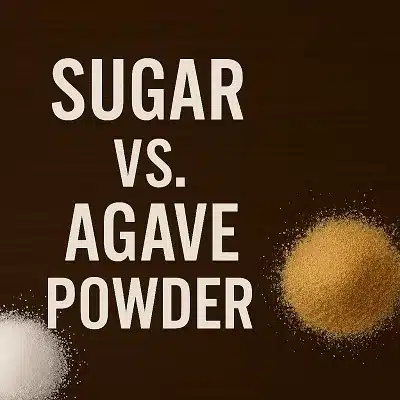Let’s talk sweeteners, the kind you actually use, not the ones some food scientist snuck into your cereal. If you’ve traded in white table sugar for agave powder, you’re already thinking differently. You want something natural. You want something that dissolves well. You want flavor without the metabolic price tag. But here’s the question: Is agave powder actually better for you than sugar? Or are we just swapping one blood sugar bomb for another in a prettier wrapper?
First, the basics.
Table sugar (sucrose) is half glucose, half fructose. It’s what most people think of when they hear “sugar”—and it hits your system fast. The glucose spikes your blood sugar and insulin, while the fructose heads to your liver, where it gets metabolized or turned into fat. That sugar rush and crash cycle? You’ve felt it. You crave more 20 minutes later and end up eating twice what you planned.
Agave powder, on the other hand, is a dried, concentrated form of agave syrup. It’s made from the sap of the agave plant, then processed into a dry sweetener that’s easy to measure, store, and mix. It’s slightly less sweet than syrup but still packs a punch—usually about 1.3 times sweeter than sugar by weight. What makes agave different isn’t the taste—it’s the high fructose content. Like agave syrup, agave powder is roughly 70–90% fructose, depending on how it’s made.
That’s where things get tricky.
Fructose doesn’t spike blood sugar the way glucose does. So yes, agave powder has a low glycemic index—usually under 20 compared to sugar’s 65–70. That sounds great on paper. Less blood sugar rollercoaster, no insulin surge, more metabolic stability. Except… the body still has to deal with that fructose load—and the liver does all the heavy lifting. Too much fructose, especially in a short window, can lead to elevated triglycerides, insulin resistance, and liver fat accumulation. Basically: stealth damage.
So what’s the verdict—is agave powder better? The answer depends on what you’re optimizing for.
If you’re:
-
Trying to avoid blood sugar spikes
-
Following a low-glycemic or low-carb plan
-
Replacing sugar in small amounts
Then yes—agave powder can be a better option, especially in a 1-teaspoon dose to flavor tea, smoothies, or water enhancers. It’s minimally processed, has plant origins, and blends well without bitterness. Just don’t let the “natural” label fool you into overdoing it.
If you’re:
-
Using sweeteners multiple times a day
-
Dealing with fatty liver, insulin resistance, or high triglycerides
-
Assuming “no glucose spike” means “no impact”
Then you’ll want to keep an eye on total intake. It’s still sugar—just in a slightly stealthier format.
Here’s the smarter way to use agave powder:
-
Stick to 1–2 teaspoons at a time. It’s sweet enough to carry flavor.
-
Pair it with fiber, protein, or healthy fat to slow absorption.
-
Avoid adding it to already-sweet foods. It works best when replacing—not layering.
-
Rotate with other natural options like monk fruit, or a touch of raw honey if you tolerate them.
The good news? Agave powder works beautifully when you’re making your own blends, especially functional drinks like citrus water enhancers. It dissolves cleanly, doesn’t overpower, and lets fruit flavors shine through. Just don’t mistake it for a “free pass” sweetener. It deserves respect—like fire, or cayenne.
Final word:
Agave powder can be better than sugar but only when used intentionally. It’s not about cutting sweeteners completely. It’s about being smart, measured, and metabolically aware. Sweeten your day, don’t sabotage it.

